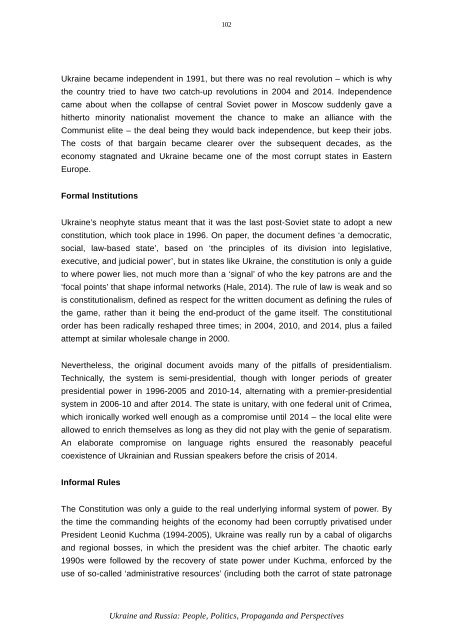Ukraine-and-Russia-E-IR
Ukraine-and-Russia-E-IR
Ukraine-and-Russia-E-IR
Create successful ePaper yourself
Turn your PDF publications into a flip-book with our unique Google optimized e-Paper software.
102<br />
<strong>Ukraine</strong> became independent in 1991, but there was no real revolution – which is why<br />
the country tried to have two catch-up revolutions in 2004 <strong>and</strong> 2014. Independence<br />
came about when the collapse of central Soviet power in Moscow suddenly gave a<br />
hitherto minority nationalist movement the chance to make an alliance with the<br />
Communist elite – the deal being they would back independence, but keep their jobs.<br />
The costs of that bargain became clearer over the subsequent decades, as the<br />
economy stagnated <strong>and</strong> <strong>Ukraine</strong> became one of the most corrupt states in Eastern<br />
Europe.<br />
Formal Institutions<br />
<strong>Ukraine</strong>’s neophyte status meant that it was the last post-Soviet state to adopt a new<br />
constitution, which took place in 1996. On paper, the document defines ‘a democratic,<br />
social, law-based state’, based on ‘the principles of its division into legislative,<br />
executive, <strong>and</strong> judicial power’, but in states like <strong>Ukraine</strong>, the constitution is only a guide<br />
to where power lies, not much more than a ‘signal’ of who the key patrons are <strong>and</strong> the<br />
‘focal points’ that shape informal networks (Hale, 2014). The rule of law is weak <strong>and</strong> so<br />
is constitutionalism, defined as respect for the written document as defining the rules of<br />
the game, rather than it being the end-product of the game itself. The constitutional<br />
order has been radically reshaped three times; in 2004, 2010, <strong>and</strong> 2014, plus a failed<br />
attempt at similar wholesale change in 2000.<br />
Nevertheless, the original document avoids many of the pitfalls of presidentialism.<br />
Technically, the system is semi-presidential, though with longer periods of greater<br />
presidential power in 1996-2005 <strong>and</strong> 2010-14, alternating with a premier-presidential<br />
system in 2006-10 <strong>and</strong> after 2014. The state is unitary, with one federal unit of Crimea,<br />
which ironically worked well enough as a compromise until 2014 – the local elite were<br />
allowed to enrich themselves as long as they did not play with the genie of separatism.<br />
An elaborate compromise on language rights ensured the reasonably peaceful<br />
coexistence of Ukrainian <strong>and</strong> <strong>Russia</strong>n speakers before the crisis of 2014.<br />
Informal Rules<br />
The Constitution was only a guide to the real underlying informal system of power. By<br />
the time the comm<strong>and</strong>ing heights of the economy had been corruptly privatised under<br />
President Leonid Kuchma (1994-2005), <strong>Ukraine</strong> was really run by a cabal of oligarchs<br />
<strong>and</strong> regional bosses, in which the president was the chief arbiter. The chaotic early<br />
1990s were followed by the recovery of state power under Kuchma, enforced by the<br />
use of so-called ‘administrative resources’ (including both the carrot of state patronage<br />
<strong>Ukraine</strong> <strong>and</strong> <strong>Russia</strong>: People, Politics, Propag<strong>and</strong>a <strong>and</strong> Perspectives


